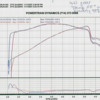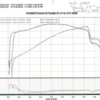Regarding the hp on an engine dyno:
Perfect conditions, no alt. no pwr steering, no acc. at all, except water pump, typically open pipes.
chassis dyno has all the acc., trans, drive line gears wheels etc.
chassis dyno also see's rotating inertia, wheel weight, tire diameter, drive shaft etc.
So I have learned recently chassis dyno do corrective numbers to compensate for all of the above variables...netting higher numbers so customer are not disapointed....
Case in fact, a friend 69 roadrunner, original Hemi car, modified exhaust with headers, reworked two four barrels, mild cam increase, professinaly tune( these guys are good). He made with his 426 HEMI 310hp at the rear wheels at 2000' elevation. No corrective math,it is what it is to the rollers.
So, I read about peope putting 400+ to the tires, are these corrected numbers or are they getting that out of cleveland. the guy's doing non corrective numbers claim typical%24-26 depending on the trans. they dont play those #, just pure HP to the rollers.
Any thoughts?
Daniel
I am curious what other chassis dyno guys do out there. I had my pondtiac engine dynoed, then chassis dynoed and was surprises, like all I thought I'd have more. but I did video it, kinda've cool, especially when nitrous is hit. I anyone wants to see it for kicks and giggles let me know and I will try to post it
Daniel
Original Post



